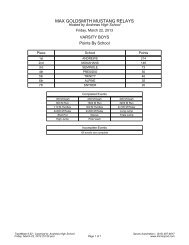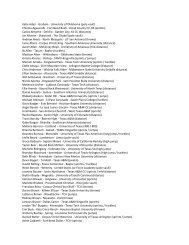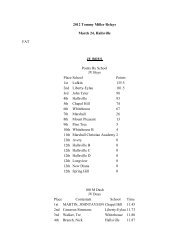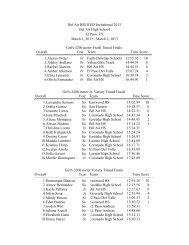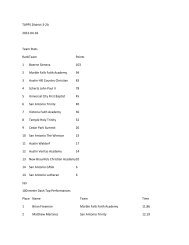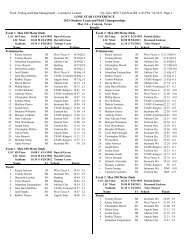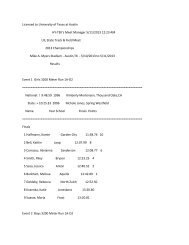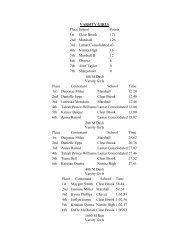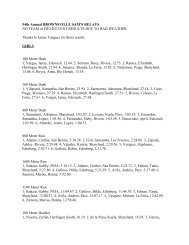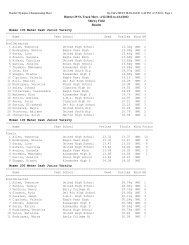1. PAGES 1-35 - Texas Track & Field Coaches Association
1. PAGES 1-35 - Texas Track & Field Coaches Association
1. PAGES 1-35 - Texas Track & Field Coaches Association
Create successful ePaper yourself
Turn your PDF publications into a flip-book with our unique Google optimized e-Paper software.
RESULTS<br />
Following a six-week intervention,<br />
all qualitative and<br />
quantitative data were analyzed<br />
to determine whether<br />
weekly use of motor imagery<br />
exercises by the athletes had<br />
any effect on their levels of<br />
confidence in track and field.<br />
Following separate analysis of<br />
the quantitative and qualitative<br />
results, triangulation was<br />
used to compare the two sets<br />
of results and determine<br />
whether the results supported<br />
each other and whether<br />
past research supported the<br />
results of this investigation.<br />
review and discuss the imagery journal. This time served to<br />
ensure that the athletes were properly following the procedures<br />
and were using correct MG-M imagery techniques and<br />
situations.<br />
Post-intervention. Immediately following the last scheduled<br />
structured imagery session, athletes were instructed to submit<br />
their imagery journals so that the researcher could verify<br />
the frequency of the participants’ individual imagery sessions.<br />
The TSCI was administered again, and the athletes<br />
were given as much time as they required to respond to the<br />
reflective prompt. Athletes who had not recorded at least<br />
three personal sessions each week throughout the six week<br />
intervention were excluded from the results, which were analyzed<br />
in detail following the post-intervention procedures.<br />
QUANTITATIVE RESULTS<br />
Before beginning motor<br />
imagery, the median TSCI<br />
score was 87 (N=7; M=83.3;<br />
SD=18.5). Following the sixweek<br />
intervention, the athletes<br />
took the TSCI again to<br />
determine whether the program<br />
had any influence on<br />
their sport confidence. After<br />
six weeks of motor imagery,<br />
the median TSCI score rose<br />
to 99 (M=92.3; SD=15.5), a<br />
difference of 12 (See Figure 1<br />
for a graphical representation<br />
of participants’ pre- and<br />
post-intervention TSCI<br />
scores). Upon further investigation,<br />
it was discovered that<br />
one participant was a significant<br />
outlier, negatively skewing<br />
the mean and distorting<br />
the standard deviation.<br />
Following a re-analysis of results and the removal of the outlier<br />
from both the pre-intervention and post-intervention<br />
TSCI scores, the pre-intervention TSCI score mean was 89.3<br />
(N=6; SD=10.2), which was closer to the overall median score<br />
of 87. The post-intervention score reanalysis resulted in a<br />
mean score of 98.3 (SD=6.0), also much closer to the overall<br />
median score of 99. These results showed an average<br />
increase of 9.0 on the post-intervention TSCI scores compared<br />
to the pre-intervention baseline scores, an improvement<br />
of nearly one standard deviation (Z=0.88; see Table 1<br />
for complete pre- and post-intervention TSCI score results).<br />
Individual results showed that six of the seven participants<br />
scored higher on the post-intervention TSCI than their initial<br />
score, and the only athlete that did not show improvement<br />
scored only one point less on her post-imagery TSCI.<br />
AUGUST 2011 techniques 39



